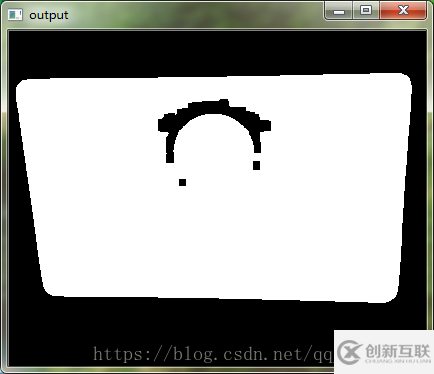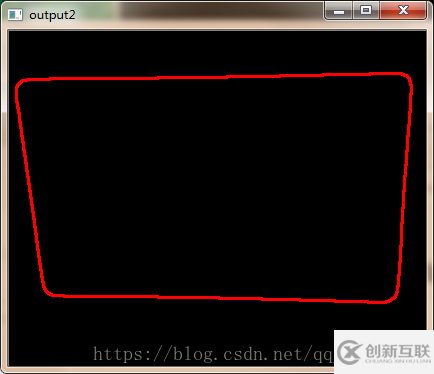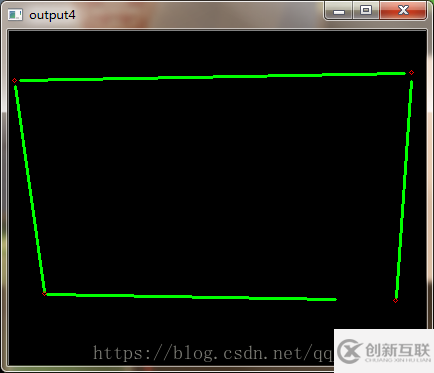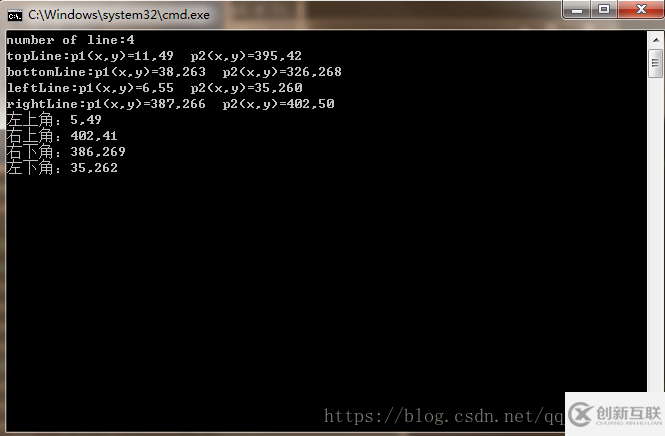Opencv中透视变换的示例分析
这篇文章主要为大家展示了“Opencv中透视变换的示例分析”,内容简而易懂,条理清晰,希望能够帮助大家解决疑惑,下面让小编带领大家一起研究并学习一下“Opencv中透视变换的示例分析”这篇文章吧。
创新互联公司是一家专业提供宜良企业网站建设,专注与成都做网站、网站建设、成都h5网站建设、小程序制作等业务。10年已为宜良众多企业、政府机构等服务。创新互联专业网络公司优惠进行中。
案例背景:对下面发生畸变的图像进行校正

方案思路:灰度二值化分割,闭操作,寻找轮廓,霍夫直线检测,直线排序,直线方程,直线交点,透视矩阵,透视变换。
#include<opencv2\opencv.hpp>
using namespace cv;
using namespace std;
int main(int arc, char** argv) {
Mat src = imread("1.jpg");
namedWindow("input", CV_WINDOW_AUTOSIZE);
imshow("input", src);
//灰度化
Mat grayImg;
cvtColor(src, grayImg, CV_BGR2GRAY);
//二值化
Mat binaryImg;
threshold(grayImg, binaryImg, 0, 255, THRESH_BINARY_INV | THRESH_OTSU);
//闭操作
Mat kernel = getStructuringElement(MORPH_RECT,Size(3,3));
morphologyEx(binaryImg, binaryImg, MORPH_CLOSE,kernel,Point(-1,-1) ,3);
imshow("output", binaryImg);
//寻找轮廓
Mat draw = Mat::zeros(src.size(), CV_8UC3);
vector<vector<Point>>contours;
findContours(binaryImg, contours, RETR_EXTERNAL, CHAIN_APPROX_SIMPLE, Point());
for (int i = 0; i < contours.size(); i++) {
Rect rect = boundingRect(contours[i]);
if (rect.width < src.cols / 2 && rect.height < src.rows / 2)continue;
drawContours(draw, contours, i, Scalar(0, 0, 255), 2);
}
imshow("output2", draw);
//霍夫直线检测
vector<Vec4i> lines;
cvtColor(draw, draw, CV_BGR2GRAY);
HoughLinesP(draw, lines, 1, CV_PI / 180, src.rows/2,src.rows/2,0);
Mat draw2 = Mat::zeros(src.size(), CV_8UC3);
for (int j = 0; j < lines.size(); j++) {
Vec4i ln = lines[j];
line(draw2, Point(ln[0], ln[1]), Point(ln[2], ln[3]), Scalar(0, 255, 0), 2);
}
printf("number of line:%d\n", lines.size());
imshow("output3", draw2);
//寻找与定位直线
Vec4i topLine,bottomLine,leftLine,rightLine;
for (int j = 0; j < lines.size(); j++) {
Vec4i ln = lines[j];
if (ln[1] < src.rows / 2 && ln[3] < src.rows / 2) {
topLine = ln;
}
if (ln[1] > src.rows / 2 && ln[3] > src.rows / 2) {
bottomLine = ln;
}
if (ln[0] < src.cols / 2 && ln[2] < src.cols / 2) {
leftLine = ln;
}
if (ln[0] > src.cols / 2 && ln[2] > src.cols / 2) {
rightLine = ln;
}
}
cout << "topLine:p1(x,y)=" << topLine[0] << "," << topLine[1]<<" " << "p2(x,y)=" << topLine[2] << "," << topLine[3] << endl;
cout << "bottomLine:p1(x,y)=" << bottomLine[0] << "," << bottomLine[1] << " " << "p2(x,y)=" << bottomLine[2] << "," << bottomLine[3] << endl;
cout << "leftLine:p1(x,y)=" << leftLine[0] << "," << leftLine[1] << " " << "p2(x,y)=" << leftLine[2] << "," << leftLine[3] << endl;
cout << "rightLine:p1(x,y)=" << rightLine[0] << "," << rightLine[1] << " " << "p2(x,y)=" << rightLine[2] << "," << rightLine[3] << endl;
//求解直线方程
float k1, c1;
k1 = float((topLine[3] - topLine[1])) / float(topLine[2] - topLine[0]);
c1 = topLine[1] - k1*topLine[0];
float k2, c2;
k2 = float((bottomLine[3] - bottomLine[1])) / float(bottomLine[2] - bottomLine[0]);
c2 = bottomLine[1] - k2*bottomLine[0];
float k3, c3;
k3 = float((leftLine[3] - leftLine[1])) / float(leftLine[2] - leftLine[0]);
c3 = leftLine[1] - k3*leftLine[0];
float k4, c4;
k4 = float((rightLine[3] - rightLine[1])) / float(rightLine[2] - rightLine[0]);
c4 = rightLine[1] - k4*rightLine[0];
//求解直线交点
Point p1;
p1.x = (int)((c1 - c3) / (k3 - k1));
p1.y = (int)(k1*p1.x + c1);
Point p2;
p2.x = (int)((c1 - c4) / (k4 - k1));
p2.y = (int)(k1*p2.x + c1);
Point p3;
p3.x = (int)((c2 - c4) / (k4 - k2));
p3.y = (int)(k2*p3.x + c2);
Point p4;
p4.x = (int)((c2 - c3) / (k3 - k2));
p4.y = (int)(k2*p4.x + c2);
cout << "左上角:" << p1.x << "," << p1.y << endl;
cout << "右上角:" << p2.x << "," << p2.y << endl;
cout << "右下角:" << p3.x << "," << p3.y << endl;
cout << "左下角:" << p4.x << "," << p4.y << endl;
//画出交点
circle(draw2, p1, 2, Scalar(0, 0, 255));
circle(draw2, p2, 2, Scalar(0, 0, 255));
circle(draw2, p3, 2, Scalar(0, 0, 255));
circle(draw2, p4, 2, Scalar(0, 0, 255));
imshow("output4", draw2);
//透视变换
vector<Point2f> srcCorners(4);
srcCorners[0] = p1;
srcCorners[1] = p2;
srcCorners[2] = p3;
srcCorners[3] = p4;
vector<Point2f> dstCorners(4);
dstCorners[0] = Point(0, 0);
dstCorners[1] = Point(src.cols, 0);
dstCorners[2] = Point(src.cols, src.rows);
dstCorners[3] = Point(0, src.rows);
Mat warpMartrix = getPerspectiveTransform(srcCorners, dstCorners);//Mat warpMartrix = findHomography(srcCorners, dstCorners);
Mat result = Mat::zeros(src.size(), -1);
warpPerspective(src, result, warpMartrix, result.size(),INTER_LINEAR);
imshow("output5", result);
waitKey(0);
return 0;
}
原图像

二值化闭操作

寻找轮廓

霍夫直线

直线及其交点

效果图

以上是“Opencv中透视变换的示例分析”这篇文章的所有内容,感谢各位的阅读!相信大家都有了一定的了解,希望分享的内容对大家有所帮助,如果还想学习更多知识,欢迎关注创新互联行业资讯频道!
本文题目:Opencv中透视变换的示例分析
本文路径:https://www.cdcxhl.com/article12/iehcgc.html
成都网站建设公司_创新互联,为您提供自适应网站、网页设计公司、搜索引擎优化、小程序开发、网站改版、做网站
声明:本网站发布的内容(图片、视频和文字)以用户投稿、用户转载内容为主,如果涉及侵权请尽快告知,我们将会在第一时间删除。文章观点不代表本网站立场,如需处理请联系客服。电话:028-86922220;邮箱:631063699@qq.com。内容未经允许不得转载,或转载时需注明来源: 创新互联

- 网站导航如何做优化布局设计 2022-12-09
- 网站建设怎样去设计一个合理的网站导航 2016-04-09
- 设置对用户有利的网站导航 2021-08-10
- 网站导航SEO优化的5大要素 2015-12-19
- 网站导航优化的要点分别有哪些 2023-04-07
- 网站导航建设如何遵循关键词优化技巧? 2022-08-04
- 如何优化网站导航结构和恢复降权方法 2022-06-06
- 网站建设如何设计好网站导航 2022-05-23
- 网站导航 2021-06-14
- 网站建设良好的网站导航把握以下几点原则 2016-08-20
- 为什么很多SEOer非常注重网站导航? 2015-05-13
- 网站导航是网站建设的重要一项 2022-09-25